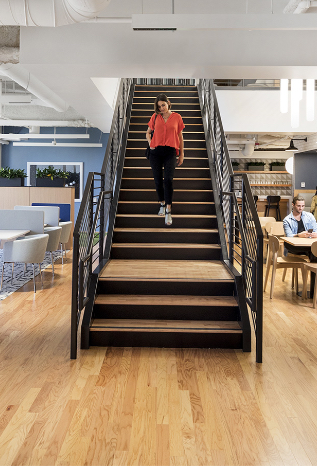More and more people entering office jobs today have higher expectations about the flexibility that employers offer. From parents wanting to commit to the school run to students needing hours that fit around their studies, the ability to work flexibly is becoming more important for younger generations when considering the types of companies they want to work for.
However, flexible working is not just beneficial to staff. It has been shown that creating a more flexible environment can also positively impact productivity in the workplace. Let’s discuss how.
What is flexible working?
According to gov.UK, flexible working is “…a way of working that suits an employee’s needs, for example having flexible start and finish times, or working from home.” All employees have a legal right to request flexible working; however, in order to be eligible, they must have worked for the same employer for at least 26 weeks.
Flexible working examples
If you’re considering looking into flexible working for yourself, it’s essential to understand the variety of ways flexible working can be used within the workplace to ensure you choose the best route for you.
Here are some common and some less well-known forms of flexible working that you can request from your employer.
Job sharing
Sharing the job role with another employee and splitting the hours between you.
Working from home
Working at home rather than in the office – this could be full weeks, particular days or half days for example.
Staggered hours / Flexitime
Instead of working the same 9-5 as everyone else, working staggered hours gives you permission to work alternative start and finish times for your coworkers.
Time off in lieu
Instead of receiving additional pay for any overtime, employers may agree to give you the time off equal to the additional hours worked.
Annualised hours
Instead of working set hours daily as is traditional, employees on annualised hours can request a set amount of hours over the course of a year and can choose when these hours are taken. Employers may request certain ‘Core hours’ in the day are still met; for example, the employee must work at least 2-5 pm each day.
Term-time work
This option allows the employee to have time off during school holidays and work during term time.
Compressed hours
Although employees must work their agreed contracted hours it can be done so over fewer days – meaning if you need every Friday off for personal reasons, for example, you can do so without needing to use a holiday.
Part-time
Employees may request part-time hours, meaning reduced hours, which will result in fewer worked days each week. This may be agreed upon as a temporary agreement, with the prospect of the employee returning to full-time work, or it could be a permanent agreement.
Self-rostering
Self-rostering means that the employee has a say and in fact, draws up their own working hours to match your preferred hours. There may be requirements your employer sets; however, this is not always the case.
Phased retirement
This allows older workers to gradually reduce their hours and eventually work part-time as they lead up to their retirement date.
How does flexible working improve productivity
According to a survey conducted in 2021 by Gartner, 43% of respondents noted that their productivity improved as a result of flexible working, and 30% stated that less or no time commuting allowed for higher levels of productivity – this is likely to be due to flexible working.
Let’s look at the 7 Ways Flexible Working Can Improve Productivity
- Better work-life balance
With less time spent travelling; employees can gain hours back on their day and have more time to spend with their families or doing things that they enjoy outside of work. Having a more flexible schedule can allow parents to be more involved in their children’s lives, doing the school run and attending shows and sports events. Employees can also be more involved in their hobbies and therefore are more likely to feel more fulfilled in both home and work life.
- Reduced absence rates
Having a flexible work setup is helpful for those who are unwell short or long-term and those who need a frequent amount of time out of work for medical reasons. For example, working from home can help employees who are bed-bound or unable to travel due to mobility issues, whilst compressed hours can ensure employees who need weekly doctor appointments can do so whilst still completing their contracted hours.
- Supports mental health and well-being
In the 2019-20 Flexible Working Survey by Wildgoose, 39% of people who work flexibly said that doing so gave more opportunities to reduce stress and better manage their mental health. Having more control over your working day and taking breaks when necessary can be a great way to ensure your employees take the time they need to take care of their mental health and well-being.
According to CIPDs 2022 Survey report on Health and wellbeing at work, 81% of organisations are offering tailored support through means such as flexible working to better employee health and well-being. Furthermore, 73% of organisations in 2022 found that flexible work options and a better work-life balance helped reduce stress in the workplace.
- Better job satisfaction
Being able to work from home and have more control over work-life balance helps employees have more autonomy in the workplace and therefore feel more trusted and valued by their employer. When employees feel valued, they are much more likely to go above and beyond for their employer.
- More cost-efficient
For both the employer and the employee, flexible working can help with costs. The savings from utilising well-designed day offices and coworking spaces are noteworthy for employers, with many options available for all sizes of businesses. Employees benefit too from reduced travelling costs, which helps alleviate financial stress.
- Better engagement
Working on a schedule that works best for you is a great way to boost productivity. Having more control over their day, employees will feel more motivated and ready to focus when the time to work comes around.
- Improved communication
Those requesting flexible work schedules may need to do so for various reasons, from mental health, children, working as a carer for a family member, or physical health difficulties. If an employee requests flexible working and they are granted it, you will find they feel more comfortable discussing any other barriers they need help overcoming and are less likely to hide them out of fear of losing their jobs. This will develop a loyalty to the business and a greater desire to give back to their employer who has supported them.
Day office benefits
If employees choose to work from home, they may decide that occasionally they want somewhere to go to work for anywhere between an hour to a full day. This is where day offices can come in handy. Day office benefits include such things as the following –
- Having a quiet room to work in is helpful if employees who typically work from home are having work done in their house and need a quiet space to work.
- Fast Wi-Fi – some employees may lack this at home and rent out day offices for better internet connection
- Comfort – as some may come with breakout spaces and recreational rooms
- Assisting employees with getting into ‘work mode’, which can be difficult to do from home occasionally, especially if there are at-home distractions
- Giving employees office space which they may not have space for in their own homes
- Employees can rent out office space during their own working hours with 24-hour day offices
- Less time travelling – when looking for the best day office for you, you may find offices just around the corner from your home. This means less time commuting and a better work-life balance
- Networking opportunities – meeting people from other companies that are also renting out day office space
RELATED: What is a Coworking Space?
It may seem counter-intuitive to request the ability to work from home and then rent out a day office. However, the purpose of flexible working is to give employees the choice of when they want to go into the office (if at all) and how long. Working in offices can help provide a better work-life balance for those that find it hard to separate their workspace from their home life, give an escape from home and a change of scenery and offer opportunities to meet new people in a professional environment.
RELATED: Why Freelancers Are Opting For Flexible Office Space
Why not take a look at our day offices today and find your ideal work-life balance?

